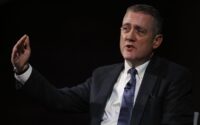When Does the Sizzling Economy Hit a Recession Brick Wall? – Mish Talk
Greg IP one of my favorite WSJ writers says the Bond Market Forecasts Bad Economic News.
Since the start of the year, investors appear to have reassessed the interest-rate outlook. Bonds have sold off, with the 10-year Treasury yield, which moves in the opposite direction to its price, jumping to 1.7% from 1.5% at the end of 2021.
Yet there are good reasons to think today’s sizzling economy may be just a temporary respite. Looked at over the longer term, real yields have been declining for decades. Olivier Blanchard, the former chief economist at the International Monetary Fund, makes this point in a new book, “Fiscal Policy Under Low Interest Rates.” In it he notes that safe interest rates—in other words, those on risk-free government debt—have been declining in the U.S., Western Europe, and Japan for 30 years. “Their decline is due neither to the Global Financial Crisis of the late 2000s, nor to the current Covid crisis, but to more persistent factors,” he writes. “Something has happened in the last 30 years, which is different from the past.”
Neel Kashkari, president of the Federal Reserve Bank of Minneapolis, said in supporting higher rates this year that he is weighing two opposing risks. One is that high inflation becomes embedded in the public’s behavior, which would require even higher interest rates later on. The other is that after Covid-19 passes, the world returns to the pre-pandemic regime of low growth and low inflation. That regime, he wrote on the publishing site Medium, was driven by “demographics, trade, and technology factors. It is unlikely that these underlying forces have gone away.”
Slower population growth reduces demand for cars, houses and other durable goods, and the need for business to expand capacity. Lengthened life expectancy means people spend more of their lives retired, so they save more in anticipation. In combination, these effects tend to hold down interest rates.
A hit to productivity
Apart from population, the main contributor to growth is productivity, and that too appears to have suffered during the pandemic. While businesses stepped up digitization by investing more in e-commerce, cloud computing and artificial intelligence, productivity has still suffered because of Covid-19 protocols and restrictions, and sweeping changes in where, and whether, people chose to work. The recent rise in inflation suggests the U.S. can’t grow as fast as before without straining productive capacity. Some of those barriers to growth are likely to persist even after the pandemic passes.
Meanwhile, Chinese investment has slowed under the impact of its own Covid-19 restrictions and cooling property sector.
What if investment and economic growth weaken, but inflation stays high? If inflation settles at, say, 3.5%, as some economists expect, then bond yields could also double to 3.5% with real rates remaining zero. In the U.S., though, high and volatile inflation eventually led to higher real interest rates, while in other countries such as Japan, stagnant growth and low inflation have gone hand in hand.
For now, investors think inflation is coming down, and will average 2.5% over the next 10 years, based on the yields on regular and inflation-indexed bonds. But Joe Gagnon, an economist at the Peterson Institute for International Economics, warns: “Bond markets have never predicted an outburst of inflation. So why would we think they can now?” He adds: “They respond very quickly when inflation starts to rise.”
Population Growth
Low Growth Factors
One thing Greg IP failed to mention is unproductive debt. The US is swimming in it.
He did mention productivity and demographics, two points I strongly agree with.
But also mentioned one thing I strongly disagree with, the alleged savings glut in China.
The Savings Glut Thesis: What is the True Net Savings?
Let’s review The Savings Glut Thesis: What is the True Net Savings?
Savings Glut?!
Former Fed chair Ben Bernanke says interest rates are so low because of Part 3: The Global Savings Glut.
What is Saving?
Saving = Production – Consumption
Here’s a classical example. A farmer producers 100 bushels of wheat. He eats 10 of them and saves 90. But wheat rots. So he sells those 90 bushels for dollars. Those dollars are now his saving.
Personal Savings
Take a look at the above chart.
The three spikes are three rounds of Covid stimulus, the first under Trump and the second two spikes under Biden.
This money was handed out willy-nilly.
What was produced? The answer of course is nothing.
Total Credit Market Debt Owed
Total credit market debt owed is $85.9 trillion!
That number comes from the Fed.
How much of that can possibly be paid back?
Something Happened
“Something has happened in the last 30 years, which is different from the past,” says Minneapolis Fed president Neel Kashkari.
Yes, it has and the Fed is clueless as to what it is.
The answer is unproductive debt is a huge drag on the economy. And the Fed needs to keep interest rates low to support that debt.
This keeps zombie corporations alive and also spurs financial speculation, also a drag on growth.
When Does Recession Hit?
If the Fed does get in three rate hikes in 2022, then 2023 or 2024. And it may not even take three hikes.
Thanks for Tuning In!
Like these reports?
If so, please Subscribe to MishTalk Email Alerts.
Subscribers get an email alert of each post as they happen. Read the ones you like and you can unsubscribe at any time.
If you have subscribed and do not get email alerts, please check your spam folder.
Mish
[ad_2]
Source link






